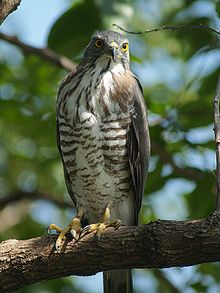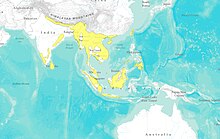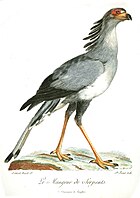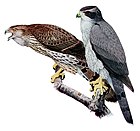Crested goshawk
| Crested goshawk | |
|---|---|

| |
| Adult male | |
| Scientific classification | |
| Domain: | Eukaryota |
| Kingdom: | Animalia |
| Phylum: | Chordata |
| Class: | Aves |
| Order: | Accipitriformes |
| Family: | Accipitridae |
| Genus: | Lophospiza |
| Species: | L. trivirgata
|
| Binomial name | |
| Lophospiza trivirgata (Temminck, 1824)
| |

| |
| Range map yellow: possible residence. | |

The crested goshawk (Lophospiza trivirgata) is a bird of prey in the family Accipitridae that is widely distributed in tropical Asia. It was formerly placed in the genus Accipiter.
Taxonomy
[edit]The crested goshawk was formally described in 1824 by the Dutch zoologist Coenraad Jacob Temminck under the binomial name Falco trivirgatus.[2][3] It was formerly placed in the very large genus Accipiter. When molecular phylogenetic studies found that Accipiter was polyphyletic, the genus was split to create monophyletic genera.[4][5] As part of this reorganisation, the genus Lophospiza was resurrected to accommodate the crested goshawk and the closely related Sulawesi goshawk. The genus had originally been erected in 1844 by the German naturalist Johann Jakob Kaup.[6] The genus name combines the Ancient Greek λοφος (lophos) meaning "crest" and σπιζιας (spizias) meaning "hawk".[7] The specific epithet trivirgata combines the Latin tri meaning "three" with virgatus meaning "striped".[8]
Eleven subspecies are recognised:[6]
- L. t. indica (Hodgson, 1836) – northeast India to south China, Indochina and the Malay Peninsula
- L. t. formosae (Mayr, 1949) – Taiwan
- L. t. peninsulae (Koelz, 1949) – southwest India
- L. t. layardi (Whistler, 1936) – Sri Lanka
- L. t. trivirgata (Temminck, 1824) – Sumatra
- L. t. niasensis Mayr, (1949) – Nias (west of north Sumatra)
- L. t. javanica Mayr, (1949) – Java and Bali
- L. t. microsticta Mayr, (1949) – Borneo
- L. t. palawana Mayr, (1949) – Palawan group (southwest Philippines)
- L. t. castroi (Manuel & Gilliard, 1952) – Polillo (north Philippines)
- L. t. extima (Mayr, 1945) – southeast Philippines
Description
[edit]This raptor has short broad wings and a long tail, both adaptations to manoeuvring through trees. It is 30–46 cm in length, with the female much larger than the male. The larger size and a short crest, clearly visible in profile, are the best distinctions from its relative, the besra (Tachyspiza virgata).[9]
The male has a dark brown crown, grey head sides and black moustachial and throat stripes. The pale underparts are patterned with rufous streaks on the breast and bars on the belly. The larger female has a browner head and brown underpart streaks and bars. The juvenile has pale fringes to its head feathers, and the underpart background colour is buff rather than white.[9]
The flight is a characteristic "slow flap, slow flap, straight glide", similar to other Accipiter species such as the Eurasian goshawk (Astur gentilis).[9]
Range and ecology
[edit]The crested goshawk breeds in southern Asia, from India and Sri Lanka to southern China, Indonesia, Taiwan, and the Philippines. It is primarily a lowland bird, and an all-year resident. Even in upland habitat it is resident in winter, for example in the Himalayas foothills of Bhutan or in Sal (Shorea robusta) forest in India's Dehradun district. In these lands at the northern end of its range, it is generally very rare however. Essentially it is limited to tropical and warm subtropical areas.[10] In Malaysia and Singapore there is increasing evidence of this species adapting to life in urban centres.[11]
Like its relatives, this secretive forest bird hunts birds, mammals and reptiles in woodland, relying on surprise as it flies from a perch to catch its prey unaware. It builds a stick nest in a tree and lays two or three eggs.[9]
The ischnoceran louse Degeeriella storeri is a parasite of this bird; it is not yet known from any other host species. On the other hand, Kurodaia fulvofasciata, an amblyceran louse parasitizing the crested goshawk, is widely found on birds of prey throughout the Holarctic.[12]
In Hong Kong, A. trivirgatus is a protected species under Wild Animals Protection Ordinance Cap 170. It can be found in Kam Shan Country Park.
References
[edit]- ^ BirdLife International (2016). "Accipiter trivirgatus". IUCN Red List of Threatened Species. 2016: e.T22695462A93510676. doi:10.2305/IUCN.UK.2016-3.RLTS.T22695462A93510676.en. Retrieved 12 November 2021.
- ^ Temminck, Coenraad Jacob (1824). Nouveau recueil de planches coloriées d'oiseaux, pour servir de suite et de complément aux planches enluminées de Buffon (in French). Vol. 1. Paris: F.G. Levrault. Plate 303, livraison 51. The 5 volumes were originally issued in 102 livraison (parts), 1820-1839. For the dates see: Dickinson, E.C. (2001). "Systematic notes on Asian birds. 9. The Nouveau recueil de planches coloriées of Temminck & Laugier (1820–1839)". Zoologische Verhandelingen, Leiden. 335: 7–53.
- ^ Mayr, Ernst; Cottrell, G. William, eds. (1979). Check-List of Birds of the World. Vol. 1 (2nd ed.). Cambridge, Massachusetts: Museum of Comparative Zoology. p. 324.
- ^ Catanach, T.A.; Halley, M.R.; Pirro, S. (2024). "Enigmas no longer: using ultraconserved elements to place several unusual hawk taxa and address the non-monophyly of the genus Accipiter (Accipitriformes: Accipitridae)". Biological Journal of the Linnean Society: blae028. doi:10.1093/biolinnean/blae028.
- ^ Mindell, D.; Fuchs, J.; Johnson, J. (2018). "Phylogeny, Taxonomy, and Geographic Diversity of Diurnal Raptors: Falconiformes, Accipitriformes, and Cathartiformes". In Sarasola, J.H.; Grange, J.M.; Negro, J.J. (eds.). Birds of Prey: Biology and conservation in the XXI century. Cham, Switzerland: Springer. pp. 3–32. ISBN 978-3-319-73744-7.
- ^ a b Gill, Frank; Donsker, David; Rasmussen, Pamela, eds. (August 2024). "Hoatzin, New World vultures, Secretarybird, raptors". IOC World Bird List Version 14.2. International Ornithologists' Union. Retrieved 21 August 2024.
- ^ Jobling, James A. "Lophospiza". The Key to Scientific Names. Cornell Lab of Ornithology. Retrieved 21 August 2024.
- ^ Jobling, James A. "trivirgatus". The Key to Scientific Names. Cornell Lab of Ornithology. Retrieved 21 August 2024.
- ^ a b c d Grimmett et al. (1999)
- ^ Grimmett et al. (1999), Inskipp et al. (2000), Singh (2002)
- ^ Shepherd (2018)
- ^ Elbel & Price (1973), Dalgleish (2003)
Sources
[edit]- Dalgleish, R.C. (ed.) (2003): Birds and their associated Chewing Lice: Accipitridae. Version of 2003-AUG-30. Retrieved 2009-JUN-23.
- Elbel, Robert E. & Price, Roger D. (1973): Three new Oriental and New Guinean Degeeriella (Mallophaga: Philopteridae). Pacific Insects 15(1) : 95-101. PDF fulltext
- Grimmett, Richard; Inskipp, Carol, Inskipp, Tim & Byers, Clive (1999): Birds of India, Pakistan, Nepal, Bangladesh, Bhutan, Sri Lanka, and the Maldives. Princeton University Press, Princeton, N.J.. ISBN 0-691-04910-6
- Inskipp, Carol; Inskipp, Tim & Sherub (2000): The ornithological importance of Thrumshingla National Park, Bhutan. Forktail 14: 147–162. PDF fulltext Archived 2008-10-11 at the Wayback Machine
- Singh, A.P. (2002): New and significant records from Dehra Dun valley, lower Garhwal Himalayas, India. Forktail 18: 151–153. PDF fulltext
- Shepherd, C. R. (2018). Crested Goshawk Accipiter trivirgatus may adapt well to life in urban areas across its range in Asia. BirdingASIA 29: 34–35.




